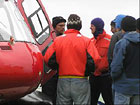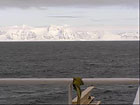

 | |||||||||||||||||
|
|
Journals 2007/2008Kathy Couchon
May 30, 2007 Latitude/Longitude: 77°06' N, 10°50.0' E I awoke early again this morning, at 5:00 AM, for a meeting with the AUV team and to discuss the work to be done. Because we operate on a 24 hour clock, all time is in military time, so I will try to adhere to that format. I awoke at 0500. Our scheduled start time gets a little earlier each day as we approach the first test site. It was particularly difficult to get up today as I spent a very restless night, with the ship rolling from side to side for quite a while very early this morning. My bunk is aligned "starboard to port" so when the ship sways and rolls, you scoot from the head of the bed to the foot and back again. It might make more sense to have "fore to aft" alignment so your head is always towards the front of the ship and rolling creates more of a rocking motion. All I know is that I was not ready to hear the alarm at 0445. There was still a bit of rocking movement throughout the morning, but except for a few brief queasy moments, I think I have my sea legs. The tasks today were to check the electronic connections of the sensors on the PUMA and JAGUAR AUVs. Because the work is largely electronic, I was not much help to the team except for some support assembling float panels on one AUV. Later in the day, around 1200, we passed the archipelago of Svarlbard. Such stark, snow-enveloped scenery it was, especially when the briefs rays of sun appeared to illuminate the rugged mountains. At about 1600 (4:00 PM) we passed the closest we would come to the islands, at least until we return to disembark in a week and a half. Each day we see a POD (Plan of the Day) posted in Odenplan, the main gathering space on Deck 1 (Övre Däck in Swedish) of the ship. Scheduled for today was the helicopter safety briefing. It will be necessary for the helicopter to go out onto the ice at times during the cruise. The science team will need to deploy transponders for tracking the location of the AUVs and at times it may make more sense to deploy them from the ice than from the ship. Flying out over the ice and landing onto it can be quite dangerous, so for this reason all of the science party was required to report to the Helideck on Deck 2 (2: Däck) for the briefing. We were advised how to dress for the helicopter excursions, where to find and how to put on the safety flotation suits. We learned how to approach and board the helicopter, and where the pilot has stored and secured the gun to protect us from polar bears when out on the ice. Yes, whenever anyone ventures onto the ice, they must be accompanied by a gunman; polar bears, though exciting to see, are extremely dangerous animals. We continued on our northward journey, steaming towards the ice. It is expected that we will reach the ice edge at about 0300 and I want to be on the bridge to experience the approach of the ice edge. It has been a long day for me; I set my watch alarm for 0230 and retire, dreaming of seeing the ice again.
|
||||||||||||||||


